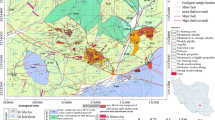Abstract
Nowadays, geometallurgical modeling, as a rapidly growing discipline in mining engineering, has significant role in mine designing/planning especially for porphyry copper projects. In porphyry copper deposits, the copper ore often is composed of two main parts including oxide and sulfide ores. The oxide rock type consists a fraction of total copper which would be recovered by heap leaching. Flotation plant is used when the fraction of sulfide ore is high enough. The mineralogical inequality constraint linking both grade variables (total copper and oxide copper) is a difficulty which often complicates the joint modeling and simulation of variables. To simplify such complicated joint simulation, the stepwise conditional transformation technique is presented which transforms multiple variables to the univariate and multivariate Gaussian with no cross correlation. This makes it easy to simulate multiple variables with arbitrarily complex relationships. This study addresses the application of stepwise conditional transformation and sequential Gaussian simulation for reproduction of the total and oxide copper in different rock types of the Sungun porphyry copper deposit honoring the relationship between Cu-oxide and Cu-total of the initial data. Validation results show that the simulation model has a good agreement with the sample data and geological facts of deposit.












Similar content being viewed by others
References
Asghari O, Hezarkhani A (2008) Applying discriminant analysis to separate the alteration zones within the Sungun porphyry copper deposit. J Appl Sci 8(24):4472–4486
Asghari O, Hezarkhani A, Soltani F (2009) The comparison of alteration zones in the Sungun porphyry copper deposit, Iran (based on fluid inclusion studies). Acta Geol Pol 59(1):93–109
Barnett RM, Deutsch CV (2012) Practical implementation of non-linear transforms for modeling geometallurgical variables. In: Abrahamsen P, Hauge R, Kolbjornsen O (eds) Geostatistics Oslo. Springer, Netherlands
Barnett RM, Manchuk JM, Deutsch CV (2013) Projection pursuit multivariate transform. Math Geosci. doi:10.1007/s11004-013-9497-7
Boisvert JB, Rossi ME, Ehrig K, Deutsch CV (2013) Geometallurgical modelling at Olympic Dam. Math Geosci. doi:10.1007/s11004-013-9462-5
Chilès JP, Defliner P (2012) Geostatistics: modeling spatial uncertainty, 2nd edn. Wiley, New York, p 699
Emery X (2012) Co-simulating total and soluble copper grades in an oxide ore deposit. Math Geosci 44:27–46
Hezarkhani A (2006) Petrology of the intrusive rocks within the Sungun Porphyry Copper Deposit Azerbaijan, Iran. J Asian Earth Sci 27:326–340
Hezarkhani A, Williams-Jones AE (1998) Controls of alteration and mineralization in the Sungun Porphyry Copper Deposit, Iran: evidence from fluid inclusions and stable isotopes. Eco Geol 93:651–670
Leuangthong O, Deutsch CV (2003) Stepwise conditional transformation for simulation of multiple variables. Math Geol 35(2):155–173
Leuangthong O, McLennan JA, Deutsch CV (2004) Minimum acceptance criteria for geostatistical realizations. Nat Resour Res 13(3):131–141
Leuangthong O, Hodson T, Rolley P, and Deutsch CV (2006) Multivariate simulation of Red Dog Mine, Alaska, USA, CIM Bulletin, May, 1–26
Pars Olang Engineering Consultant Company (2006) Pars Olang Modeling and Reserve Estimation Report of Sungun Copper Mine, Tehran
Razavizadeh H, Afshar MR (2008) Leaching of Sarcheshmeh copper oxide ore in sulfuric acid solution. Miner Metall Process 25(2):85–90
Rosenblatt M (1952) Remarks on a multivariate transformation. Ann Math Stat 23(3):470–472
Shahabpour J, Doorandish M (2007) Mine drainage water from the Sar Cheshmeh porphyry copper mine, Kerman, Iran. Environ Monit Assess 141(1–3):105–120
Shayestehfar MR, Karimi NS, Mohammadalizadeh H (2008) Mineralogy, petrology, and chemistry studies to evaluate oxide copper ores for heap leaching in Sarcheshmeh copper mine, Kerman, Iran. J Hazard Mater 154:602–612
Soltani F, Afzal P, Asghari O (2014) Delineation of alteration zones based on Sequential Gaussian Simulation and concentration-volume fractal modeling in the hypogene zone of Sungun copper deposit NW Iran. J Geochem Explor. doi:10.1016/j.gexplo.2014.02.007
Talebi H, Asghari O, Emery X (2013) Application of plurigaussian simulation to delineate the layout of alteration domains in Sungun copper deposit. Cent Eur J Geosci 5(4):514–522. doi:10.2478/s13533-012-0146-3
Williams ST (2013) A Historical Perspective of the Application and Success of Geometallurgical Methodologies, The Australasian Institute of Mining and Metallurgy, publication series No 10/2013
Author information
Authors and Affiliations
Corresponding author
Rights and permissions
About this article
Cite this article
Hosseini, S.A., Asghari, O. Simulation of geometallurgical variables through stepwise conditional transformation in Sungun copper deposit, Iran. Arab J Geosci 8, 3821–3831 (2015). https://doi.org/10.1007/s12517-014-1452-5
Received:
Accepted:
Published:
Issue Date:
DOI: https://doi.org/10.1007/s12517-014-1452-5




